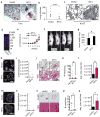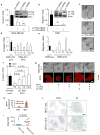MYC suppresses cancer metastasis by direct transcriptional silencing of αv and β3 integrin subunits
- PMID: 22581054
- PMCID: PMC3366024
- DOI: 10.1038/ncb2491
MYC suppresses cancer metastasis by direct transcriptional silencing of αv and β3 integrin subunits
Abstract
Overexpression of MYC transforms cells in culture, elicits malignant tumours in experimental animals and is found in many human tumours. We now report the paradoxical finding that this powerful oncogene can also act as a suppressor of cell motility, invasiveness and metastasis. Overexpression of MYC stimulated proliferation of breast cancer cells both in culture and in vivo as expected, but inhibited motility and invasiveness in culture, and lung and liver metastases in xenografted tumours. We show further that MYC represses transcription of both subunits of αvβ3 integrin, and that exogenous expression of β3 integrin in human breast cancer cells that do not express this integrin rescues invasiveness and migration when MYC is downregulated. These data uncover an unexpected function of MYC, provide an explanation for the hitherto puzzling literature on the relationship between MYC and metastasis, and reveal a variable that could influence the development of therapies that target MYC.
Conflict of interest statement
COMPETING FINANCIAL INTERESTS
The authors declare no competing financial interests.
Figures






Comment in
-
Signalling. A new role for MYC?Nat Rev Cancer. 2012 Jun 22;12(7):448-9. doi: 10.1038/nrc3308. Nat Rev Cancer. 2012. PMID: 22722394
-
To be or not to be a proliferation marker?Oncogene. 2014 Feb 20;33(8):954-5. doi: 10.1038/onc.2013.19. Epub 2013 Feb 11. Oncogene. 2014. PMID: 23396366
References
-
- Grandori C, Cowley SM, James LP, Eisenman RN. The Myc/Max/Mad network and the transcriptional control of cell behavior. Annu Rev Cell Dev Biol. 2000;16:653–699. - PubMed
-
- Pelengaris S, Khan M, Evan G. c-MYC: more than just a matter of life and death. Nat Rev Cancer. 2002;2:764–776. - PubMed
-
- Kuttler F, Mai S. c-Myc, Genomic Instability and Disease. Genome Dyn. 2006;1:171–190. - PubMed
-
- Oster SK, Ho CS, Soucie EL, Penn LZ. The myc oncogene: MarvelouslY Complex. Adv Cancer Res. 2002;84:81–154. - PubMed
Publication types
MeSH terms
Substances
Grants and funding
- CA116201/CA/NCI NIH HHS/United States
- R37 CA064786/CA/NCI NIH HHS/United States
- U54CA126552/CA/NCI NIH HHS/United States
- U54 CA143836/CA/NCI NIH HHS/United States
- U54 CA126552/CA/NCI NIH HHS/United States
- R37CA064786/CA/NCI NIH HHS/United States
- P50 CA116201/CA/NCI NIH HHS/United States
- U01CA143233/CA/NCI NIH HHS/United States
- U01 CA143233/CA/NCI NIH HHS/United States
- R01 CA122086/CA/NCI NIH HHS/United States
- P50 CA091956/CA/NCI NIH HHS/United States
- U54CA143836/CA/NCI NIH HHS/United States
- CA122086/CA/NCI NIH HHS/United States
LinkOut - more resources
Full Text Sources
Other Literature Sources

